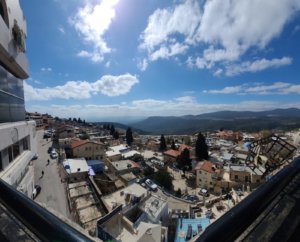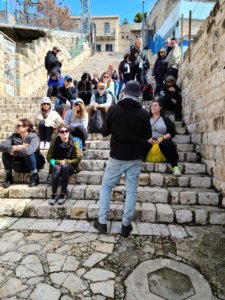TL-45-485 Update 8
Written by Shauna
Today we went to Tzfat, the ancient site of Jewish mysticism and spirituality. Tzfat is a 500-year-old city that is visibly different from the rest of Israel (that we’ve seen, anyway), save for perhaps Jerusalem. I felt something in Jerusalem, and I felt something in Tzfat as well, and the only way I can compare the two would be to say that they both were like a warm hug; Jerusalem felt like the first love you held hands with in kindergarten, and Tzfat the stranger you locked eyes with from across a crowded room and knew they would change the course of your life forever.
We met with Avraham, an artist, who taught us that we could cut up our bodies into more than 600 pieces and the Torah would still have a prayer for each of them, and that each of our souls also exists in every other person. We learned that spiritual practice is the body and that Kabbalah (Jewish mysticism) was the soul, and that our bodies were only here so that we could feel our souls.
Avraham’s art was like nothing I’d seen before: words translated into paintings, sounds translated into paintings. It was transcendent, and I felt it in all 600+ pieces of my body. A friend on the trip told me, “all of this art looks abstract, but it’s actually incredibly deliberate”, and I don’t think there is a better way to describe the colors and the shapes and the messages within that little gallery.
Tzfat as a city was very much the same. Old stone, and blue paint. We learned that all of the gates and doors were painted blue to trick the devil, so if he were to come here he would mistake the city for sea and sky and gently move past to somewhere else.
A spotlight now cuts the city in half, when it had once been divided in the middle by a wall with Jews on one half and Arabs on the other. It was nice to see that where there was once a split, there was now only light, and the streets themselves seemed like a cause for celebration for the Jews. But we made a point to remember that for every cobblestone there is an Arab family who misses home, walking down streets in countries around the world with keys around their neck for doors right here in Tzfat.
We learned of the Hasidim, who have kept their lifestyle intact throughout the ages, refusing to change even something as little as the direction in which their hat was tilted. I couldn’t help but notice how sharply this contrasted with the rest of Israel, which we’ve learned is so motivated to grow and evolve.
I was reminded of an anecdote I’d heard a long time ago, regarding compromise. If we have two people, and one set of shoes, it seems so easy to think that each person should get one shoe. But if the ground is hot, neither person will be able to walk very far with only one shoe. Instead, we should give one person both shoes, and that person should carry the other, and both will make it through. This is the paradox of Israel, I think.
Israel is the mix of everything; the west and east, the fast and the slow. We visited Tzfat on Shabbos, and we saw that in a city where everything takes place in the street, they still had a day to go inward. We can all take a lesson from a city that can shut down, every week for the sake of peace.








